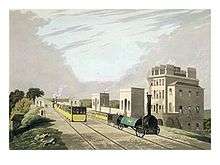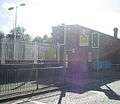Earlestown railway station
| Earlestown | |
|---|---|
.jpg) Earlestown station buildings viewed from platform 1 | |
| Location | |
| Place | Earlestown, Newton-le-Willows |
| Local authority | St Helens |
| Coordinates | 53°27′04″N 2°38′17″W / 53.451°N 2.638°WCoordinates: 53°27′04″N 2°38′17″W / 53.451°N 2.638°W |
| Grid reference | SJ578951 |
| Operations | |
| Station code | ERL |
| Managed by | Northern |
| Number of platforms | 5 |
| DfT category | E |
|
Live arrivals/departures, station information and onward connections from National Rail Enquiries | |
| Annual rail passenger usage* | |
| 2012/13 |
|
| 2013/14 |
|
| 2014/15 |
|
| 2015/16 |
|
| 2016/17 |
|
| – Interchange |
|
| Passenger Transport Executive | |
| PTE | Merseytravel |
| Zone | A1 |
| History | |
| Original company | Liverpool and Manchester Railway |
| Pre-grouping | London and North Western Railway |
| Post-grouping | London, Midland and Scottish Railway |
| 15 September 1830 | Opened as Newton Junction |
| July 1852 | Renamed Warrington Junction |
| November 1861 | Renamed Earlestown Junction |
| 5 June 1950 | Renamed Earlestown |
| National Rail – UK railway stations | |
| * Annual estimated passenger usage based on sales of tickets in stated financial year(s) which end or originate at Earlestown from Office of Rail and Road statistics. Methodology may vary year on year. | |
|
| |
Earlestown railway station is a railway station in Earlestown, Merseyside, England, and one of the few "triangular" stations in Britain.
Early history
The station lies on the former Liverpool and Manchester Railway, which was opened on 15 September 1830. On 25 July 1831 the Warrington and Newton Railway was opened for public use, making a junction at a point in the township of Newton, facing in the direction of Liverpool.
The surviving Earlestown station buildings were constructed around 1835 on the original site, at the point of intersection of these two early railways, incidentally forming the first steam railway junction, which was given the name Newton Junction.
The junction had a very tight curvature and this caused problems. Train travelling on the curves were restricted to a slow maximum speed. The original building now forms the (currently unused) waiting room of Earlestown Station.
The Grand Junction Railway (GJR) absorbed the Warrington and Newton company as of 31 December 1834 and from the GJR's completion of their trunk line from Birmingham on 4 July 1837 used it to access the Liverpool and Manchester line. A new "Curve" was built at Newton Junction so that trains could run towards Manchester; this gave the station a triangular formation with six platforms. To complicate matters, there was also a branch line from Richard Evans's collieries at Haydock which had a curve to join the L & M in the Manchester direction and passed through the triangle to join the Warrington and Newton line.
The method of operation involved the despatch of a Grand Junction train from both Liverpool and Manchester to meet at Earlestown. These were joined together and continued as one train to Birmingham. Both portions conveyed through carriages after 1839 to London. The Grand Junction trains arriving from Birmingham were usually split at Warrington (Bank Quay) and passed through Earlestown as separate Liverpool and Manchester trains.
An area between the station and the "Nine Arches" viaduct was selected in 1833 by Messrs Jones, Turner and Evans as the site of their Viaduct Locomotive Works. In 1853, the London and North Western Railway took a lease on the premises and thus established the company's carriage and wagon works, and the area developed into something of a 'company town' which, after the construction of company houses, was given the nickname "Earle's Town" after James Hardman Earle, a director of the company and its predecessors, the Liverpool & Manchester and Grand Junction Railways. The name has stuck, despite it being corrupted to its present version and never having been an actual town.
Later history
The London and North Western Railway later operated their main line service to the Scottish border by way of Earlestown and Parkside, utilising a short section of the old Liverpool and Manchester line. This inconvenient routing was eliminated by the construction of the Golborne cut-off, a direct connection avoiding Earlestown. The original route, on the eastern section of the triangle, was electrified at 25kV as part of the West Coast Main Line electrification, since it was then used by a few trains stopping at Earlestown.
In the Beeching Report of 1963, Earlestown was listed as one of the stations to be closed, but it remained open along with other stations between Liverpool and Manchester that had also been listed such as Huyton and Edge Hill. However, direct trains to St Helens Shaw Street via St Helens Junction were withdrawn in 1964.
The remaining parts of the station were electrified as part of the North West electrification, which was announced in July 2009. This project saw the original West Coast Main Line electrification joined to the Manchester to Liverpool electrification at the east and south sides of Earlestown station. This electrification work was completed in February 2015.
At present, there are frequent services to Liverpool (Lime Street), Manchester (Victoria and Airport), Warrington (Bank Quay), Chester and then via the North Wales Coast Line to Llandudno.
Scheduled electrically operated passenger services commenced from the station during March 2015, when the Liverpool Lime Street to Manchester Airport service converted from diesel to electric traction. Previously, despite the long-standing electrification of part of the station, no electrically operated passenger services were scheduled to call at Earlestown.
Historical status

Earlestown is one of two triangular train stations left in the UK, the other being Shipley in West Yorkshire
The triangular track layout at Earlestown represents the oldest junction in the world between two passenger railways, in the form of the first "stationary turntable" or wye ever constructed. Nearby on the line towards Liverpool is the Sankey Viaduct, the first mainline railway viaduct. It crosses the Sankey Canal, which is claimed to be the world's first purpose-built industrial waterway.
The waiting room on the Liverpool-bound platform is the oldest station building in the world still in passenger service, although this is now limited to providing shelter from the rain under its canopy. The building is currently derelict, with tickets being sold in a more recent structure on the opposite side of the line.
Facilities
The ticket office is staffed for the duration of service here each day (06:00 to midnight weekdays and Saturdays, 08:30 to midnight Sundays). Digital information screens, timetable poster boards and automatic announcements provide train running information. All platforms have either shelters or canopies. Only platforms 1 and 5 have step-free access, as the others are reached via the stepped footbridge between platforms 1 and 2.[1]
Services
- Platform 1 for services to Manchester Victoria and Crewe via Manchester Airport via Newton-le-Willows; operated by Northern
- Platform 2 for services to Liverpool Lime Street (from Manchester Victoria and Manchester Airport), via St Helens Junction; operated by Northern[2]
- Platform 3 for services between Warrington Bank Quay and Liverpool (bidirectional platform); operated by Northern
- Platform 4 for services to Manchester Piccadilly and Manchester Airport (since the service extension introduced by Arriva Trains Wales on 16 May 2016) via Newton-le-Willows and Manchester Oxford Road; operated by Transport for Wales
- Platform 5 for services to Chester and Llandudno, via Warrington and Helsby; operated by Transport for Wales
Passengers for Holyhead or Wrexham/Shrewsbury (for connections to South Wales and Birmingham) must change at Chester, though there are a pair of through trains to and from Holyhead on weekdays only in the current (May 2018) timetable (along with one as far as Bangor on Saturdays only).[3]
Following completion of electrification of the line in Spring 2015, the Liverpool to Manchester Airport, Liverpool to Manchester Victoria and Liverpool to Warrington Bank Quay services are now operated by 4-Car Class 319 Electric Units.
Most routes serve the station hourly in each direction, though certain trains (such as the TransPennine Express Liverpool Lime Street to Newcastle/Scarborough via York fast services) pass through without stopping. The only services calling here on Sundays are those between Lime Street and Manchester Airport/Wilmslow (Northern) and Manchester Piccadilly and Chester (ATW); the Liverpool - Warrington B.Q and Liverpool - Manchester Victoria stopping trains do not operate.
Gallery
 The station ticket office.
The station ticket office..jpg) An Arriva Trains Wales Class 158 departs from platform 5.
An Arriva Trains Wales Class 158 departs from platform 5..jpg) A Northern Rail Class 156 waits at the station.
A Northern Rail Class 156 waits at the station..jpg) The oldest station building in the world, which is still in passenger service.
The oldest station building in the world, which is still in passenger service.
See also
Notes
- ↑ Earlestown station facilities National Rail Enquiries; Retrieved 22 December 2016
- ↑ Table 90 National Rail timetable, May 2018
- ↑ Table 81 National Rail timetable, May 2018
References
- Butt, R. V. J. (1995). The Directory of Railway Stations: details every public and private passenger station, halt, platform and stopping place, past and present (1st ed.). Sparkford: Patrick Stephens Ltd. ISBN 978-1-85260-508-7. OCLC 60251199.
- Liverpool & Manchester Railway 1830-1980, Frank Ferneyhough, Book Club Associates, 1980, (no ISBN)
- Awdry, Christopher (1990). Encyclopaedia of British Railway Companies. Sparkford: Patrick Stephens Ltd. ISBN 1-8526-0049-7. OCLC 19514063. CN 8983.
| Preceding station | Following station | |||
|---|---|---|---|---|
| Warrington Bank Quay | Transport for Wales Chester to Manchester Line |
Newton-le-Willows | ||
| St Helens Junction | Northern Liverpool to Manchester Line (Warrington spur) |
Warrington Bank Quay | ||
| St Helens Junction | Northern Liverpool to Manchester Line (Northern route) |
Newton-le-Willows | ||
External links
| Wikimedia Commons has media related to Earlestown railway station. |
- Train times and station information for Earlestown railway station from National Rail